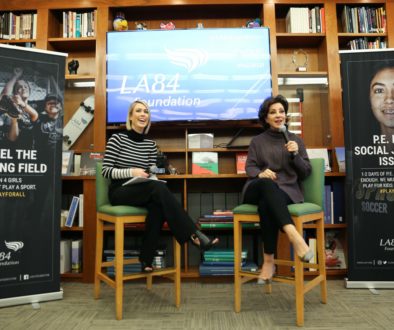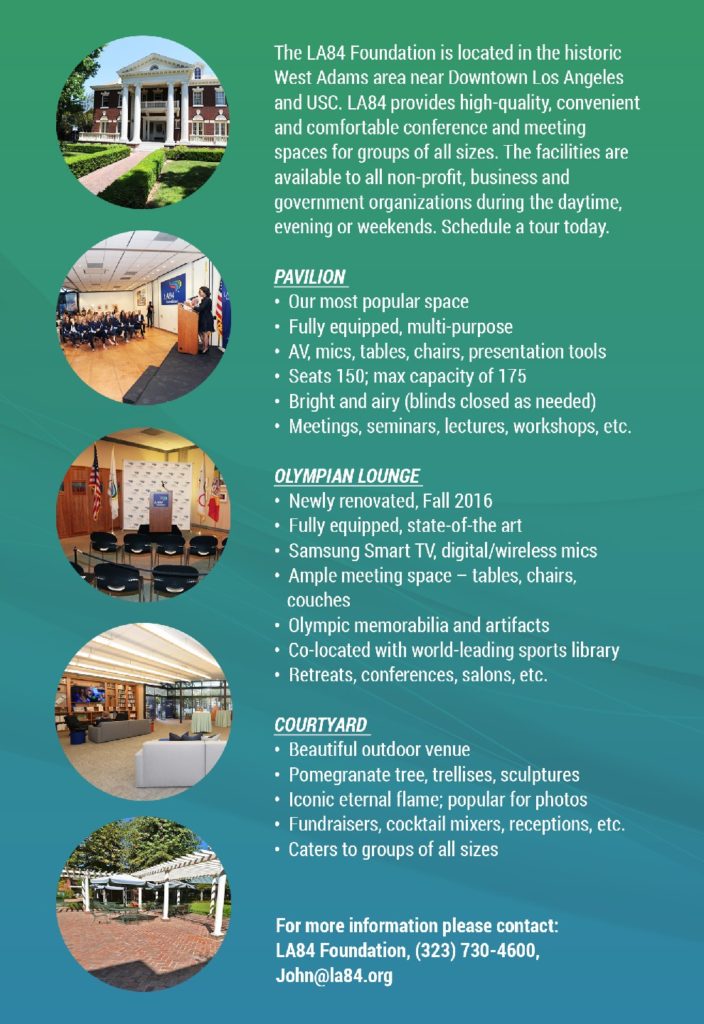SL Interview: Elizabeth Kristen Fights for Gender Equity in Sports
Last year marked the 40th anniversary of the passage of Title IX of the Educational Amendment of 1972, the groundbreaking law that prohibits gender discrimination in federally funded educational programs. That includes athletic programs, of course, and Title IX is credited with helping to level the playing field for female athletes in the high school and collegiate ranks.
The occasion of the anniversary prompted many journalists to write that Title IX has been a resounding success. These commentators often cited the substantial growth in female participation in athletics as proof. For example, they noted that scholarships for women participating in intercollegiate athletics did not exist in 1972; today, over 190,000 women play college sports.
Participation numbers are only one measurement of gender equity, however, and critics of Title IX are quick to point out that the disparities that existed before 1972 have not been completely eradicated. The boys’ football team gets a state-of-the-art scoreboard and new uniforms, while the girls’ softball team must be satisfied with using a baseball field. As the National Women’s Law Center recently concluded, “Despite the fact that Title IX has opened many doors for women and girls in athletics, schools across the country are still not providing equal opportunities for girls to participate in sports and are not treating girls’ teams equally in terms of benefits and resources.”
One organization that continues to monitor the efficacy of Title IX is Fair Play for Girls in Sports. Fair Play is a project within the offices of The Legal Aid Society-Employment Law Center (LAS-ELC) in San Francisco. Fair Play has focused its efforts on securing equality for girls at the elementary, middle, and high school levels. In addition, it has brought attention to AB 2404, a little-publicized law in California that calls for equal access to athletic opportunities at the local parks and recreation departments. This issue is particularly important in low-income communities, which are often more dependent on park and rec programs and facilities and which often show a large disparity in athletic participation between girls and boys.
Elizabeth Kristen is the director of the Gender Equity & LGBT Rights Program and a senior staff attorney at the LAS-ELC. Kristen graduated from University of California, Berkeley, Law School in 2001. She spent a year clerking for James Browning on the Ninth Circuit Court of Appeals in San Francisco. She first came to LAS-ELC in 2002 on a fellowship from the Skadden Foundation, described as “the legal Peace Corps,” because it allows recent law school graduates to pursue public interest law. In 2003, she helped start the Fair Play program (originally known as the Title IX K-12 Equality Project).
SportsLetter spoke with Kristen about Title IX, AB 2404, and gender equity in sports by phone from her office in San Francisco.
— David Davis
SportsLetter: First, can you explain what Fair Play for Girls in Sports project is all about?
Elizabeth Kristen: The Fair Play project focuses on bringing gender equity to school athletic programs and to local park and recreation programs – especially for girls from low-income communities and communities of color. We believe in education and outreach, so a big component of our work is giving community presentations about the requirements of Title IX, the federal law, and AB 2404, which is the California law that requires equality in the local park and recreation programs. We’ve given a lot of presentations to the American Association of University Women, up and down the state. We’ve also presented to a group called Coaching Corps, based in Oakland. They focus on providing coaches to low-income communities and communities of color, and making sure that kids have opportunities for competitive play. We’ve done presentations to Girls on the Run, another non-profit that focuses on low-income girls, and making sure they have the opportunity to participate in a mentoring-based running program.
We’ve done some presentations directly to youth. That’s something that we’d like to do more of. Oftentimes, they’re too young to know what their rights are. They don’t know how to advocate for themselves. Mostly, we give presentations to community members and to the youth advocates, to the people who might be looking out for and finding these problems on behalf of youth.
Another tool that we use, when we have to, is to bring enforcement actions for failure to comply with Title IX. We always try to resolve these cases with the school district at the beginning because it’s better for everybody. We have had success in doing that. We’ll reach out on behalf of parents or coaches and talk to the schools and say, “Here’s what Title IX requires, here’s why you’re not in compliance, and don’t you want to fix it?” We had success with the Torrance School District that way. They were very cooperative. We were able to reach an agreement and made some great improvements for girls at Torrance West High.
SL: AB 2404 was passed into law in California in 2004: What does the law say?
EK: This came from a series of lawsuits filed by the ACLU of Southern California on behalf of girls who were being discriminated against in parks and recreation programs. Then-Assembly member [now state senator] Darrell Steinberg took the lead on this bill [officially called Gender Equity in Community Youth Athletics].
The law addresses the basic inequality in the number of girls participating in community youth athletic programs, and it requires that Title IX-like standards be applied to community youth park and recreation programs. Equal participation opportunities just like Title IX, and equal treatment and benefits just like Title IX.
SL: How much awareness of the law is there throughout the state?
EK: As far as we can tell, there is very little compliance and very little awareness. There have been no reported cases whatsoever being brought under this law. We’ve met with a number of different park and rec. programs, mostly in the Bay area, trying to figure out what they’re doing. Most of them are not even collecting data on how many girls participate in their athletic programs versus how many boys participate in them. They don’t even know. So, that’s one problem.
Another problem is the type of programs and classes that they’re offering to girls. One park and rec program — it’s in Fresno — was offering princess classes for girls and offering real athletic programs for boys. Who knew that you needed a class to learn how to make magical wands and crowns?
It’s interesting because the state of Washington followed California’s lead on this law and passed its own version. They’ve named it the Fair Play in Community Sports Act. What the state did there was, with the help of the ACLU, create a tool kit, sort of a model policy, that each park and rec. department can adopt. What we’re trying to do with Coaching Corps — our non-profit partner in Oakland — is to create a similar tool kit and to give local park and rec departments throughout California the tools that they can use to assess their programs and measure whether they’re in compliance with AB 2404. We want to make it practical and useful for them. That’s why we’ve been looking for a park and rec partner to sit down with us and say, practically speaking, this policy works or doesn’t work.
SL: Why is AB 2404 so important for low-income girls and girls of color?
EK: For those girls the local park and rec programs may be the only opportunity they have to participate in athletics, especially pre-high school. There are very few after-school athletic offerings for grade school or middle school students. For the more wealthy girls, their parents can pay for them to be in, say, club soccer or club water polo. But those clubs are incredibly expensive. They also require the parents to invest a substantial amount of time — taking their kids to and from practices and games.
If you’re a girl who is part of a low-income family, it’s likely that both your parents work. It’s possible that you’re being asked to take on a job or take care of your brothers and sisters at home. So, you may not be able to participate in those kinds of private programs. But if you have a local park and rec. center that’s providing an opportunity for you, that might be something that you’re more likely to participate in, especially to the extent that the park and rec people are engaged in their communities and respond to the community’s needs and concerns.
That type of opportunity, in turn, can help these girls with sports when they get to high school or even college. But if they can’t develop those fundamental skills at a pretty young age, and they don’t get a chance to play until they get to high school — and who they’re competing against has been going to AYSO soccer ever since they could walk — it’s unlikely that they’re going to get that chance to play in high school.
SL: What are the most common forms of discrimination with the local park and rec programs? Is it access to facilities? Decent officials?
EK: What we’ve been seeing and hearing a lot anecdotally is, first of all, sports offerings: there’s just not enough offerings made to girls and there’s not enough active recruitment of girls. We also hear quite a bit about facility inequality. A lot of community programs have traditions, for example, of the Little League team always getting first dibs on scheduling and fields. Or, the boys soccer league always gets to choose first what field times they need, or what fields they get to use. So then, maybe girls don’t get the same access to the soccer fields or they don’t get access at the best game times or they don’t get access to the best fields.
The other thing we see is that communities will build baseball fields, but they won’t build any softball fields. Or, they’ll build what they call multi-use fields that are not proper regulation softball fields. So, the girls are forced to play on a baseball field or on a multi-use field that is inadequate.
SL: Do you think the local park and rec departments have publicized the law to the community?
EK: No, I don’t think that they have. We’ve talked to some departments and, frankly, they don’t even know about the law. If you go up on different websites, you’ll see which cities have addressed it. I think the city of West Covina has publicized it, for instance, and I think L.A. has as well.
We are working with the California Parks and Recreation Society — which is the membership organization for the local departments and their members. We’ve just sent out, with the Society’s help, a survey to all of their members about what they know about the law and what they think about gender equity. When we get the results of the survey, we’ll be able to analyze the data and we’ll put out a report about that.
SL: Has Fair Play filed any lawsuits over AB 2404?
EK: We haven’t. We really want to try everything we can to have a cooperative approach and to see if we can get the park and rec departments engaged and moving forward on this issue. In the future, I wouldn’t take it off the table. We would file a lawsuit if the facts presented themselves and we weren’t able to resolve the question.
SL: What was your sports background?
EK: I was a Title IX girl myself growing up in Lincoln, Nebraska. In the early 1970s, when my mom was in law school, she took me to lobby for Title IX. When I got back to school, they were passing around a flyer for boys’ basketball. I said, “Wait a second. Isn’t that something that I’m supposed to play, too?” So, with my mom’s help, I became the only girl on the boys’ team at that time.
I developed a lifelong passion for girls participating in athletics because I know what a difference it made in my life. I played basketball from junior high all through high school. I played soccer and ran track and cross country. I just loved participating in sports. It was an important part of my education. I think anybody who’s been an athlete knows that you learn certain things playing sports: discipline, organization, teamwork. All those things that are really good for being a professional or for any kind of job.
SL: What are the benefits of playing sports for girls and how does it involve employment opportunities?
EK: Most of us are now well aware of the tremendous benefits to girls of participating in athletics. Some of these are totally obvious — like health benefits. Some of the other benefits are educational: girls who participate in sports are more likely to complete school, to stay out of trouble, and to go on to college.
Part of the reason why our office got involved in this issue is that there is a strong connection between participation in athletics and employment. Not only does it mean that girls are more likely to enter the labor force and get jobs, but they’re also likely to have higher wages if they participated in athletics. So, we really view it as a pathway out of poverty in a lot of ways.
SL: What has Title IX meant to girls and women in sports?
EK: There’s no doubt that, since 1972, there has been tremendous progress for women and girls in athletics. The numbers are outstanding. Before Title IX, fewer than 300,000 girls participated in high school athletics. Now it’s more than 3,000,000. We’ve seen college opportunities and scholarship money increase, and growing numbers of girls are able to use athletics as a way to get to college. That’s a huge yardstick of Title IX’s success.
It’s not just the numbers that have increased. Title IX really raised the profile of women athletes in general. The public acceptance of — and understanding of and appreciation for — women participating in athletics has really increased. It’s now considered okay, and even beneficial, for girls to participate in sports. I think you saw the real effect of this last year at the Olympics. It was “the year of the women” because they were so successful.
There are still a lot of barriers. There is still a lack of compliance with Title IX. What we haven’t quite gotten is for girls to feel like it’s their right to participate in sports on an equal level with the boys. The Women’s Sports Foundation recently released a report about this, and I really liked their title: “Progress Without Equity.” We have seen tremendous progress for girls, but we don’t have equity.
SL: How would you evaluate the difference between compliance of Title IX at the collegiate level and at the high school level?
EK: I think one of the huge differences is that the NCAA has been much more active in forcing schools to take action to comply. There’s also more “sunshine” — an expression we use referring to public accessibility and accountability to data — at the college level. They are required to annually report their participation and revenue numbers and a lot more information.
That’s not the case at the high school level, at least nationally. Part of the problem is that the high school sports governing bodies are often structured from a bottom-up model. The local level seems to be where most of the control is. I think that the people at the very top statewide — like the officials who run the CIF in California — are very committed to gender equality. But I think their power to effectuate change at the local level is very limited.
There’s been introduced in Congress a bill called the High School Athletics Accountability Act. This bill would require high schools to report similar data to what the colleges have to report — about the number of boys and girls on athletic teams, about their athletic budgets, about a lot of different components of Title IX. So far, that bill has not had any success in Congress, although a number of states have passed their own versions [e.g., New Mexico, Georgia, Kentucky].
SL: What legal action has your organization taken regarding compliance of Title IX?
EK: We brought two lawsuits against high schools in Southern California for failure to comply with Title IX. The lack of compliance was quite blatant. In 2004, we brought a class-action lawsuit called Lauren Cruz et al. v. Alhambra School District. The city of Alhambra and the Alhambra School District collaborated to build brand-new, million-dollar baseball fields for the boys. There was no comparable softball field for the girls. They also had a big gym and a small gym at the high school; the big gym was the boys’ gym, and the small gym was the girls’ gym.
We litigated that case for about two years, and we had a good settlement. As part of the settlement, they built brand-new softball fields for the girls at Moor Field — a city facility — that are pretty wonderful. They also built a new team room inside the school for girls’ athletics, and the school district is required to provide equal access to playing opportunities and funding.
The other major case is in San Diego against the Sweetwater Union High School District. That one is still going on. A father of an athlete contacted us because he was concerned that his daughter and her teammates on the softball team were receiving unequal treatment. He felt that the school had not addressed a number of complaints. Then, they fired the softball coach. We investigated the situation and felt that the violations were pretty blatant. We filed a class-action lawsuit called Ollier et al. v. Sweetwater Union High School.
We won summary judgment on one of our claims in 2008. The judge found that the violations were so obvious that he granted our motion for summary judgment on part of our Title IX claim — the failure to provide equal participation opportunities for girls. We won this motion and then we won at trial on the other two Title IX causes of action. The defendants have now appealed to the Ninth Circuit.
SL: What are the misconceptions about Title IX?
EK: The number-one misconception about Title IX is that it harms male athletics. The opponents of Title IX have been very effective at putting out a negative message about Title IX whenever a school decides to eliminate or cut back athletic programs for boys. Title IX, of course, has no requirement to cut male athletics. It says nothing to the effect that female opportunities should come at the expense of boys. No one is saying, we want fewer sports opportunities for boys.
What we’ve seen is that schools make a choice to cut male athletic programs, and then they blame Title IX. Or, the media blames Title IX. I think that’s a huge misperception. Basically, what we’ve had is favoritism for male athletic programs for a really long time, and when you have a budget that’s limited you have to make some choices. You could divide up that athletic pie more fairly or you could expand the pie, but all Title IX says is, you have to do things fairly and equally.
SL: How has the financial crisis affected the issue of gender equity with sports?
EK: I’m not downplaying the financial crisis, but I think people sometimes use it as an excuse. For instance, Title IX has been around now for 40 years. In the past 40 years, there have been some good times when the money was flowing more freely. The schools and the school districts didn’t build out facilities for girls then, either.
I think there’s been some unfairness in how the pain of the financial cuts has fallen. Girls were disadvantaged in the past and they continue to be disadvantaged. In a family, when you fall on hard times, you try and share the pain. You don’t just say, “Well, none of you girls are going to get to eat steak. Only the boys are.”
The other issue that comes up with finances is outside funding. A lot of schools don’t know that the money they get from outside funding sources – like booster clubs — has to be used to provide equal benefits to girls and boys. They can’t just say, “Well, the baseball booster club decided to build the boys baseball team this great team room. The girls don’t have anything like that — too bad.” They can’t do that — just like they couldn’t accept a gift of textbooks that would only be used by the boys.
SL: How about the issue of transgender athletes and equal opportunity as that relates to Title IX?
EK: That’s definitely an emerging trend. The first questions are, what are the protocols for transgender athletes? And, when do male-to-female transgender athletes participate as a female on a female team and vice versa?
There was an excellent report that the National Center for Lesbian Rights published about transgender athletes that addresses those questions. That report brought together doctors, athletes, coaches, and athletic directors and talked about protocols for this. They realize that this is going to be a bigger issue moving forward, and it’s going to require that people be prepared for dealing with it even though it involves a small number of athletes.
Partly why it’s important, too, is that it raises this other big picture question that advocates have been talking about: the general nature of same-sex athletics versus some other model. Deborah Brake, a University of Pittsburgh law school professor, recently wrote a book about Title IX called “Getting in the Game.” She examines the idea of whether we should be advocating to continue to have sex-segregated athletics or whether we should be advocating for something else. We saw mention of this with the recent controversy over Brittney Griner and whether she should be allowed to try out for the NBA. Some people thought it was great, some people thought it wasn’t so great.
SL: Recently, the U.S. Department of Education brought attention to Section 504 of the Rehabilitation Act of 1973 to call for equal access for athletes with disabilities. Is this effort going to be the “Title IX for athletes with disabilities”?
EK: It’s a hugely interesting topic and a really important issue. For the same reason that we think girls should have access to athletics, we also think people with disabilities should have access to athletics. I have a number of colleagues with disabilities who have shared their experiences with me. Most people with disabilities are mainstreamed into schools. When it comes to P.E., they end up sitting on the sidelines instead of having an athletic activity appropriate to their disability. So now, with this renewed attention, it’s time for them to be brought into the big tent with respect to athletics.
SL: How effective has First Lady Michelle Obama been with the “Let’s Move” campaign?
EK: The “Let’s Move” campaign has gotten a tremendous amount of attention. I think it’s terrific that she’s using her prominent position for this issue. And, the fact that her girls play soccer and the President goes to their soccer games — those kinds of things are wonderful. They deserve a lot of credit for that.
The biggest complaint I hear about it that there is no funding associated with it. For those organizations that are out there doing great things for youth and are struggling financially, the “Let’s Move” campaign doesn’t have funding available to support their efforts.




